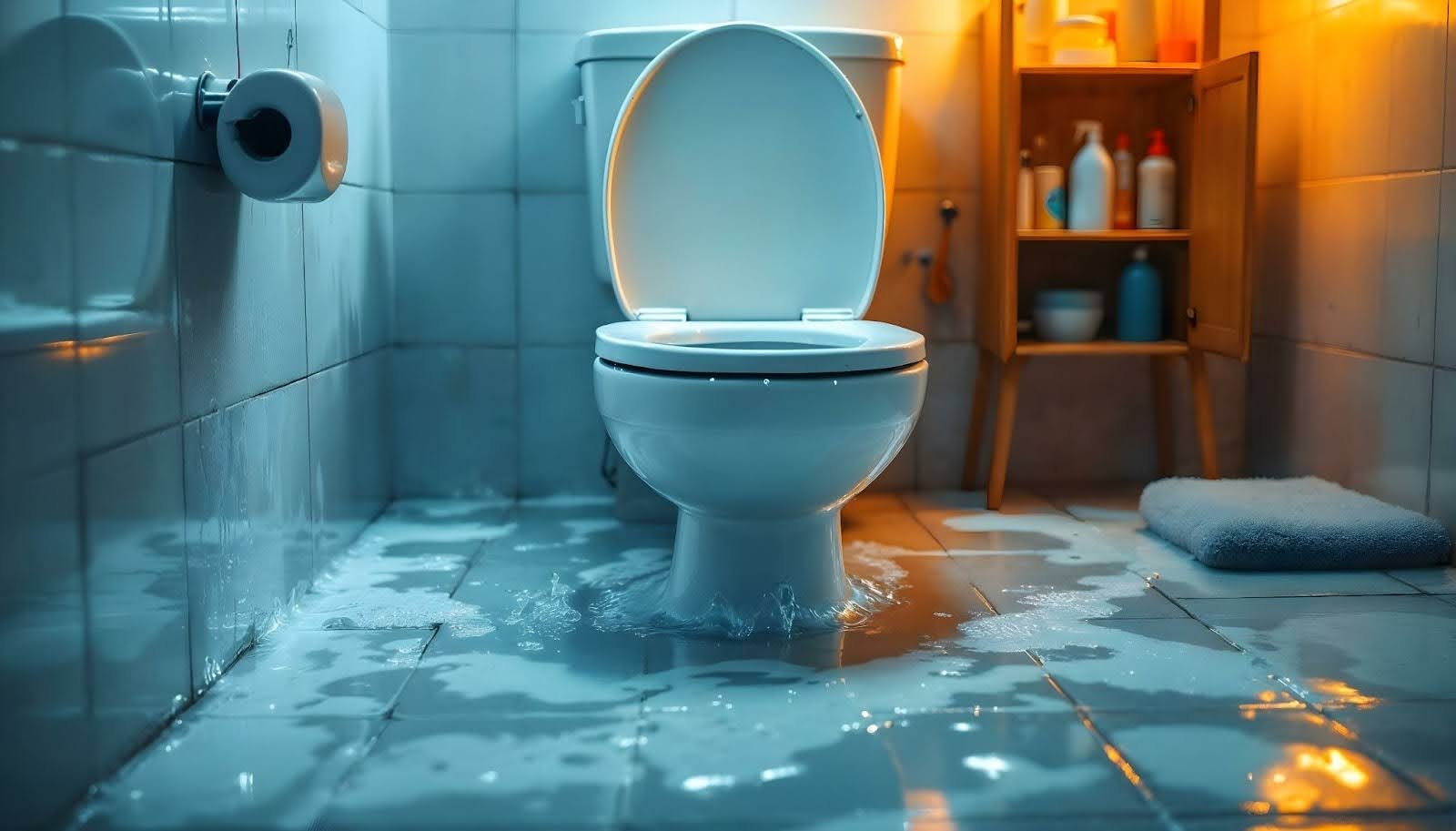A bathroom flood can be a homeowner’s worst nightmare. It is a common occurrence, largely due to the high volume of water usage in this area. With multiple pipes leading in and out of the bathroom, the risk of a flooded bathroom floor, or worse, is higher than you might imagine.
In this article, we will discuss what to do after a bathroom flood, what causes a bathroom flood, how to fix it, how to prevent it from happening again, and how to clean up the mess.
What to Do Immediately After a Bathroom Flooding?
Experiencing a bathroom flood can be overwhelming and stressful, but acting quickly is important to minimize the damage. Here are some steps you should take immediately after a bathroom flooding:
Access The Situation
The first step is to assess the extent of the damage caused by the bathroom flood. Determine if it’s safe to enter the bathroom or if any electrical hazards may pose a risk. If necessary, turn off the electricity supply to the affected area before taking the next step. Check for leaks in your drain and supply lines. After performing these checks, remove all water from the flooded bathroom floor, if possible.
Shut Off The Water
Next, locate the source of the flooding and shut off the valve nearest the leak. This could be done at individual fixtures such as sinks, toilets, or showers or at a main shutoff valve for your home.
Fix the Problem
After shutting off the water supply, it’s time to fix the problem that caused the bathroom flood. This could involve anything from unclogging a drain to repairing a broken pipe.
Depending on your level of expertise and comfort with plumbing repairs, you may need to call in a water damage professional for assistance. They will be better equipped to deal with the flooded bathroom floor, locate the leak, and fix the problem efficiently, quickly, and safely.
Call Homeowners Insurance And Document The Damage
It’s essential to contact your homeowner’s insurance company as quickly as possible after experiencing a bathroom flood. They will guide you through your coverage and explain what documentation you will need to provide.
In addition, it is important to document all damage caused by the bathroom flood with photos or videos of the leak source and flooded bathroom floor before attempting any cleanup measures. This evidence will be useful when filing an insurance claim later on.
A professional water damage repair company should be able to handle all aspects of the insurance process for you. At Wet Reset, we assist all customers with the bathroom flooding insurance process, ensuring the necessary documentation is submitted correctly and on time.
We work directly with insurance adjusters to streamline the claims process, helping you get the coverage you are entitled to without unnecessary, frustrating delays.
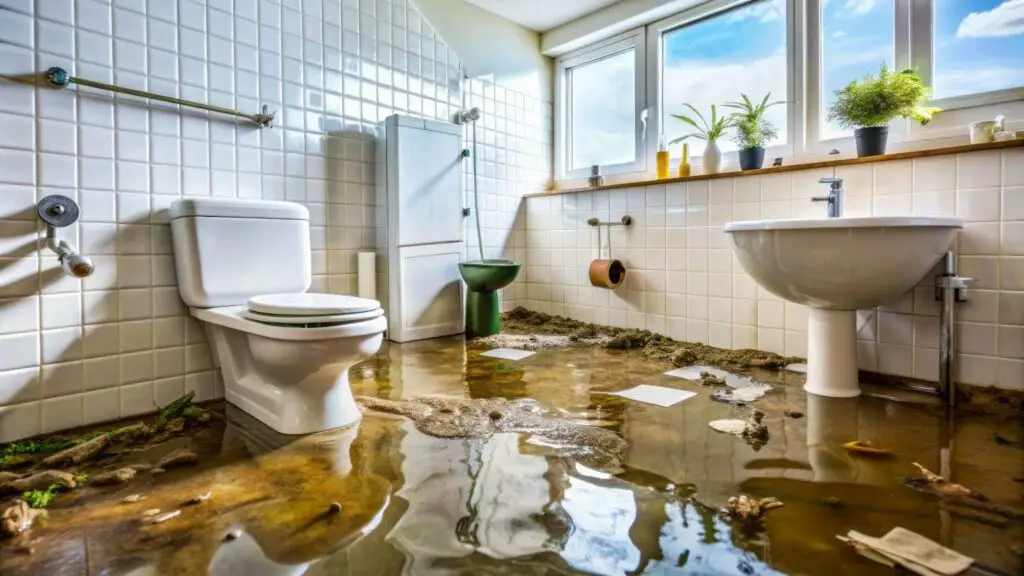
The Dangers of a Flooded Bathroom
A bathroom flood can pose serious dangers to your health and your home’s structural integrity. Here are some of the most common risks associated with a flooded bathroom floor stemming from a water leak in your property:
- Bacterial contamination from sewage backups in the bathroom: If the floodwaters contain sewage, they can be filled with harmful bacteria and pathogens that can cause illness or infection. It’s important to wear protective gear, such as gloves and boots when dealing with contaminated water.
- Potential ceiling collapse: If an upper floor experiences a bathroom flood, the water can seep into the ceiling below and cause it to weaken or collapse. This can be especially dangerous if someone is standing underneath when it happens.
- Structural damage: Water damage after a bathroom flood can weaken walls, floors, and other structural components of your home, leading to costly repairs or even collapse if left untreated for too long.
- Mold growth: Moisture from a bathroom flood creates an ideal environment for mold spores to grow and spread throughout your home. Bathroom mold can cause respiratory problems and other health issues, so it’s important to address any water damage quickly to prevent mold growth.
- Water sewage: Water from a bathroom flood may contain hazardous substances like chemicals or waste that could be harmful to you and your family’s health.
What Are the Potential Causes of Bathroom Flooding?
Identifying the root cause of a bathroom flood is critical to taking the necessary action. Here are some common causes of bathroom flooding:
Clogs – Toilet Paper Is Not The Only Problem
One of the most common causes of a bathroom flood is clogged drains. Too much toilet paper, along with hair, ‘soap scum,’ and various other debris, can build up over time and block the flow of water through pipes. If left untreated, these clogs can cause water to back up to a flooded bathroom floor or worse.
Plumbing Malfunctions – Check Your Toilet Float
A typical bathroom flood can also be caused by a malfunctioning toilet float. Over time, wear and tear can cause it to stop working correctly, resulting in an overflow when flushed. Another potential culprit is a plumbing system that’s not functioning properly due to burst and leaky pipes, worn-out valves or fixtures, and damaged seals. Issues with your toilet’s flushing mechanism or tank could also lead to overflowing and a flooded bathroom floor.
Plumbing System – Burst and Leaky Pipes
Loose faucets or hardened, cracked sink gaskets can cause water leaks in the bathroom. Even if a leak appears to have been fixed, there may be other undetected leaks.
Homes with old plumbing systems or outdated materials, such as corroded cast iron pipes, are more likely to instigate a flooded bathroom floor. These materials may not be able to handle the high-pressure water flow required by modern bathrooms.
Low Temperatures – Be aware of Freezing
During winter months, when temperatures drop below freezing point, there’s an increased risk of burst water pipes in poorly insulated homes or those located in colder climates. When water freezes inside pipes, they can easily burst, which leads to significant water damage once they thaw. Frozen pipes are one of the most common causes of a bathroom flood, especially in older homes.
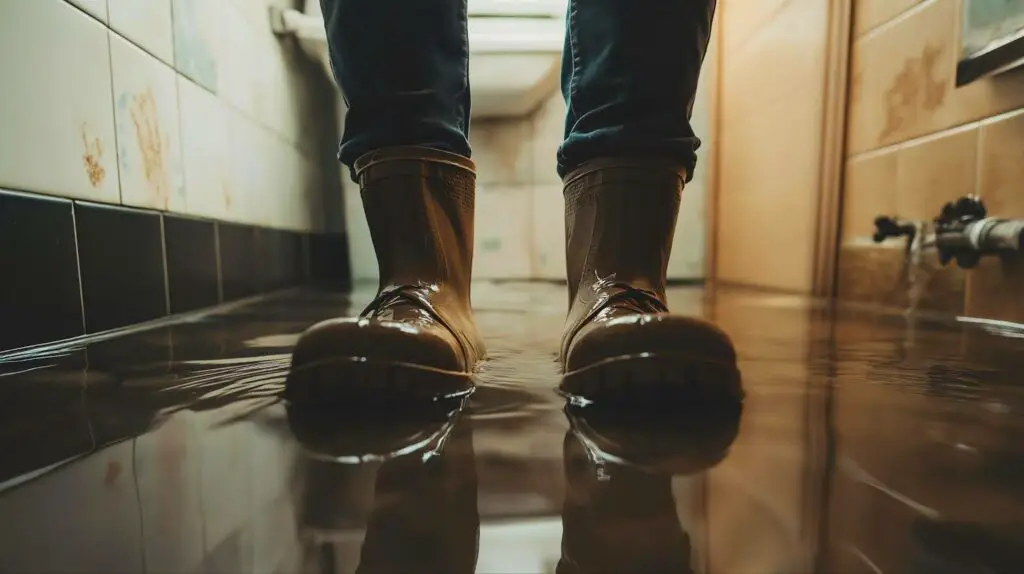
Water and Sewage backup – Check Your Septic Tank
Water and sewage backup is another potential cause of bathroom floods. If there’s a problem with your home’s sewer line or septic tank, wastewater can back up into your house through sinks, toilets, or shower heads, leading to significant flood damages if not addressed promptly.
How to Fix a Bathroom Flood?
If you’re dealing with a bathroom flood, it’s important to determine the cause of the problem. If it wasn’t due to user error, such as leaving a bath running for too long, then there may be a water leak or plumbing issue that needs to be addressed.
While some minor leaks can be fixed with DIY guides, more complex issues should be handled by a professional plumber. It’s important to locate the source of the bathroom flood before attempting any repairs. Check pipes, valves, fittings, and damp patches for any signs of damage or leakage.
How to Clean a Flooded Bathroom?
Cleaning up a bathroom flood can seem like an overwhelming job – but with the correct measures, you will be able to accomplish it efficiently. So, if your bathroom is flooded, what to do? To get started, follow these steps:
Remove Standing Water
The first step after a bathroom flood is to remove any standing water. You can use a bucket, mop towels, or a wet vac to do this. Be careful not to touch any electrical outlets or switches as they may have been affected by the bathroom flood.
Remove Damaged Objects
Remove any damaged objects, such as rugs, towels, and bath mats. If you have wood floors, check for warping or buckling and remove any wet floorboards. Clear your bathroom cabinets and any other storage that is in contact with the flooded bathroom floor.
Dry the Area
The drying process is crucial in preventing further damage and mold growth after a bathroom flood. Use a wet vac or dehumidifier to dry out carpets, floors, and walls thoroughly.
Replace and Fix
Once everything is dry, replace any damaged items, such as tiles or baseboards, that were removed during the cleaning process. If necessary, call in a professional water damage company to fix any leaks that caused the bathroom flood.
Disinfect
When a toilet overflows, it can cause significant damage to your bathroom floor and other surfaces. Floodwater is considered toxic black water, which means that it contains harmful bacteria and pathogens that can pose serious health risks
Disinfect all surfaces using bleach, white vinegar, hydrogen peroxide, or another disinfectant to kill bacteria and prevent mold growth.
Check for Mold Growth
It’s important to check for any signs of mold growth in the bathroom. If you do find any, call a professional to have it removed and treated appropriately. A bathroom flood is one of the more common causes of mold growth, as mold often transpires slowly over time.
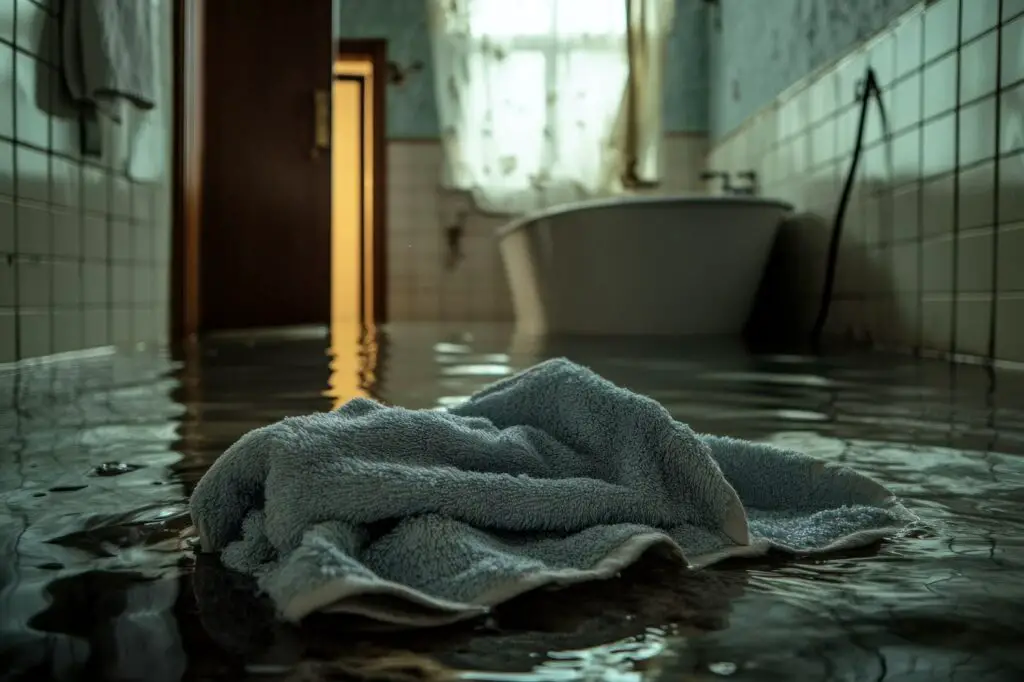
Preventing Future Bathroom Floods
Preventing a bathroom flood from occurring in the future is essential to avoid costly repairs and potential health hazards. Here are some steps you can take to prevent future bathroom floods:
- Regular Maintenance: Regular maintenance of your plumbing system can help prevent a bathroom flood. Inspect pipes, faucets, and toilets for leaks or cracks regularly. If you notice any issues, call a plumber right away.
- Install Water Alarms: Installing water alarms in your bathroom can alert you to any leaks or bathroom flooding immediately. These alarms can be placed near the toilet, bathtub, or sink and will sound an alarm when they detect water.
- Use Drain Covers: Drain covers on sinks, bathtubs, and showers can help prevent clogs that may lead to a bathroom flood. These covers catch hair and other debris before they enter the drain.
- Properly Dispose of Materials: Do not flush anything other than toilet paper down the toilet. Avoid flushing feminine hygiene products, wipes, or any other materials that could cause a clog, potentially leading to a bathroom flood.
- Check Your Water Pressure: High water pressure can damage your plumbing system over time, leading to water leaks and a flooded bathroom floor. Have a professional plumber check your water pressure and make the necessary adjustments.
- Install Backflow Preventers: A backflow preventer is a device installed in your plumbing system that prevents water from flowing back into the main supply line in case of a blockage or bathroom flood.
Is Bathroom Flooding Covered by Homeowners Insurance?
If you experience a bathroom flood, one of the first questions that may come to mind is whether your homeowner’s insurance covers the damages.
The answer depends on your specific insurance policy. In general, most standard homeowners insurance policies will cover sudden and accidental water damage caused by a burst water pipe or other plumbing issues. This means that if the bathroom flood was caused by a covered peril, such as a sudden leak in your plumbing system, then your insurance may cover the cost of repairs.
However, most homeowners insurance policies have some limitations. For example, if the bathroom flood was caused by neglect or lack of maintenance, it may not be covered. Additionally, some policies exclude coverage for floods caused by natural disasters like hurricanes or heavy rainfall.
It’s important to review your homeowner’s insurance policy carefully to understand what is covered and what is not. You may also want to consider purchasing additional coverage for bathroom floods or other types of flood damage that are not included in your standard policy.
Bottom Line
If not addressed promptly, a bathroom flood can cause serious structural damage. Water can seep into walls, floors, and ceilings, causing rot, warping, or even collapse. A certified water damage contractor can use advanced tools like moisture meters and infrared cameras to detect hidden water damage that may not be visible to the naked eye.
They will also have access to specialized drying equipment that can quickly remove moisture from the general area affected by the bathroom flood, preventing further damage and mold growth.
By hiring a certified contractor to deal with your bathroom flood, you can have peace of mind knowing that your home is in good hands and will be restored to its pre-loss condition as soon as possible.
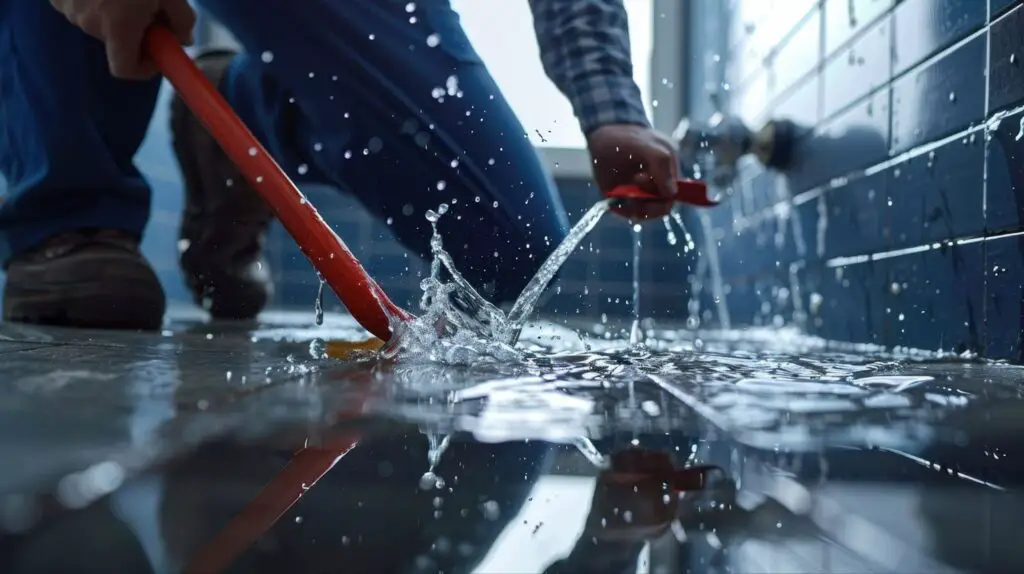
Call the Professionals at Wet Reset!
A bathroom flood doesn’t have to drastically disrupt your life – schedule an expert water damage restoration service before the issue grows out of control. Our experts are ready 24/7 to assist with quick and reliable bathroom flood repair services to protect your property and your peace of mind.
Get In Touch Today for a Free Consultation!
FAQs
What should I do if my bathroom is flooded?
If your bathroom is flooded what to do first is shut off the water supply, assess the damage, and remove all standing water. Contact a water damage specialist if needed.
What are the most common causes of a bathroom flood?
A bathroom flood is often caused by clogged drains, burst pipes, overflowing toilets, or faulty plumbing. Regular maintenance can help prevent unexpected flooding.
How to clean a flooded bathroom properly?
Start by removing standing water, drying the area with fans, and disinfecting surfaces to prevent mold and bacteria growth.
Does homeowners insurance cover bathroom flood damage?
Most policies cover bathroom flood damage from sudden plumbing failures, but neglect-related leaks or natural floods may not be included. Check your policy for details.
How can I prevent a future bathroom flood?
To avoid another bathroom flood, inspect plumbing regularly, use drain covers, install water alarms, and fix leaks promptly to prevent costly water damage.

